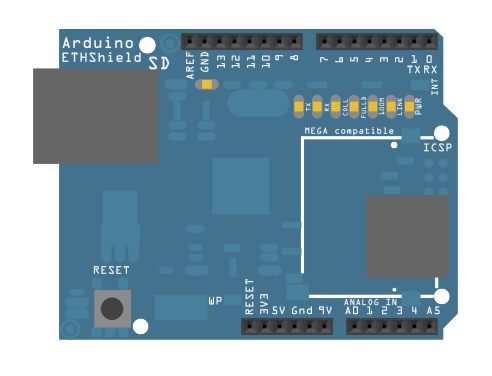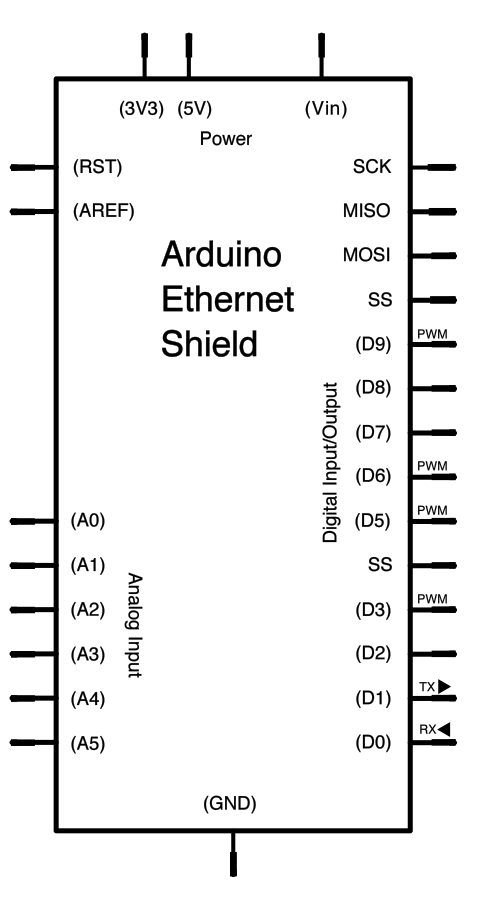Eğitimler
ChatServer
Gelen iletileri bağlı tüm istemcilere dağıtan basit bir sunucu. Kullanmak için bir terminal penceresi açın, cihazlarınızın IP adresine Telnet yazın ve yazın. Gelen metinler bağlı tüm istemcilere gönderilecektir (bir tanesi dahil). Ayrıca, müşterinin girişini seri monitörünüzde de görebilirsiniz.
Gerekli Donanım
- Arduino veya Genuino Kurulu
- Arduino Ethernet Kalkanı
Devre
Ethernet kalkanı, bir WizNet Ethernet denetleyicisini SPI veri yolu üzerinden Arduino veya Genuino kartlarına bağlamanızı sağlar. WizNet'e SPI bağlantısı için 10, 11, 12 ve 13 pinlerini kullanır . Ethernet kalkanının sonraki modellerinde de bir SD Kart bulunur. Dijital pim 4, SD karttaki ikincil seçim pimini kontrol etmek için kullanılır.
Kalkan bir ethernet kablosuyla bir ağa bağlanmalıdır. Programdaki ağ ayarlarını ağınıza uygun olacak şekilde değiştirmeniz gerekecektir.

Yukarıdaki görüntüde, Arduino veya Genuino kartı Ethernet kalkanının altına istiflenecektir.
Şematik

Kod:
Lütfen dikkat : donanım kurulumunuza göre, çizimin başındaki kütüphaneleri yorumlamanız / açmanız gerekir. Arduino Ethernet Shield 2 ve Leonardo Ethernet ile Arduino Ethernet Shield veya Ethernet2.h ile kullanın Ethernet.h.
Chat Server
A simple server that distributes any incoming messages to all
connected clients. To use, telnet to your device's IP address and type.
You can see the client's input in the serial monitor as well.
Using an Arduino Wiznet Ethernet shield.
Circuit:
* Ethernet shield attached to pins 10, 11, 12, 13
created 18 Dec 2009
by David A. Mellis
modified 9 Apr 2012
by Tom Igoe
*/
#include <SPI.h>
#include <Ethernet.h>
// Enter a MAC address and IP address for your controller below.
// The IP address will be dependent on your local network.
// gateway and subnet are optional:
byte mac[] = {
0xDE, 0xAD, 0xBE, 0xEF, 0xFE, 0xED };
IPAddress ip(192, 168, 1, 177);
IPAddress myDns(192, 168, 1, 1);
IPAddress gateway(192, 168, 1, 1);
IPAddress subnet(255, 255, 0, 0);
// telnet defaults to port 23
EthernetServer server(23);
bool alreadyConnected = false; // whether or not the client was connected previously
void setup() {
// You can use Ethernet.init(pin) to configure the CS pin
//Ethernet.init(10); // Most Arduino shields
//Ethernet.init(5); // MKR ETH shield
//Ethernet.init(0); // Teensy 2.0
//Ethernet.init(20); // Teensy++ 2.0
//Ethernet.init(15); // ESP8266 with Adafruit Featherwing Ethernet
//Ethernet.init(33); // ESP32 with Adafruit Featherwing Ethernet
// initialize the ethernet device
Ethernet.begin(mac, ip, myDns, gateway, subnet);
// Open serial communications and wait for port to open:
Serial.begin(9600);
while (!Serial) {
; // wait for serial port to connect. Needed for native USB port only
}
// Check for Ethernet hardware present
if (Ethernet.hardwareStatus() == EthernetNoHardware) {
Serial.println("Ethernet shield was not found. Sorry, can't run without hardware. :(");
while (true) {
delay(1); // do nothing, no point running without Ethernet hardware
}
}
if (Ethernet.linkStatus() == LinkOFF) {
Serial.println("Ethernet cable is not connected.");
}
// start listening for clients
server.begin();
Serial.print("Chat server address:");
Serial.println(Ethernet.localIP());
}
void loop() {
// wait for a new client:
EthernetClient client = server.available();
// when the client sends the first byte, say hello:
if (client) {
if (!alreadyConnected) {
// clear out the input buffer:
client.flush();
Serial.println("We have a new client");
client.println("Hello, client!");
alreadyConnected = true;
}
if (client.available() > 0) {
// read the bytes incoming from the client:
char thisChar = client.read();
// echo the bytes back to the client:
server.write(thisChar);
// echo the bytes to the server as well:
Serial.write(thisChar);
}
}
}
See Also
- Arduino Ethernet Shield- Ürün Açıklaması.
- Getting started with the Ethernet Shield- Her şeyi dakikalar içinde kurun.
- Ethernet library- Ethernet Kütüphanesi için referansınız.
- AdvancedChatServer- Gelen iletileri, gönderen dışındaki tüm bağlı istemcilere dağıtan bir sunucu.
- WebClient- Web'i sorgulayın ve seri monitörden cevap alın
- WebClientRepeating - Ethernet kalkanı kullanılarak tekrarlanan HTTP istekleri nasıl yapılır.
- WebServer- Analog girişin değerini gösteren basit bir web sunucusu.
- DhcpAddressPrinter- Bir DHCP adresi alın ve seri monitöre yazdırın.
- DhcpChatServer- Bir Telnet sunucusuna bağlanın ve alınan tüm mesajları seri monitörde yazdırın; DHCP kullanır.
- TelnetClient- Bir Telnet sunucusuna bağlanın ve alınan tüm mesajları seri monitörde yazdırın
- BarometricPressureWebServer- SPI kullanarak basınç sensöründen okunan verileri kaydedin.
- UDPSendReceiveString- UDP protokolü (Universal Datagram Packet) aracılığıyla metin dizeleri gönderip alın.
- UdpNtpClient- bir Ağ Zaman Protokolü (NTP) sunucusunu sorgulamak ve seri monitörden bilgi almak.
